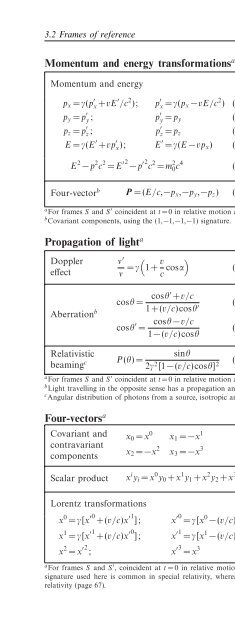You also want an ePaper? Increase the reach of your titles
YUMPU automatically turns print PDFs into web optimized ePapers that Google loves.
3.2 Frames <strong>of</strong> reference<br />
65<br />
Momentum and energy transformations a<br />
Momentum and energy<br />
γ<br />
Lorentz factor<br />
=[1−(v/c) 2 ] −1/2<br />
p x = γ(p ′ x +vE ′ /c 2 ); p ′ x = γ(p x −vE/c 2 ) (3.16)<br />
p y = p ′ y; p ′ y = p y (3.17)<br />
p z = p ′ z; p ′ z = p z (3.18)<br />
E = γ(E ′ +vp ′ x); E ′ = γ(E −vp x ) (3.19)<br />
v<br />
c<br />
velocity <strong>of</strong> S ′ in S<br />
speed <strong>of</strong> light<br />
p x ,p ′ x x components <strong>of</strong><br />
momentum in S and<br />
S ′ (sim. for y and z)<br />
E,E ′ energy in S and S ′<br />
E 2 −p 2 c 2 = E ′2 −p ′2 c 2 = m 2 0c 4 (3.20) m 0 (rest) mass<br />
p total momentum in S<br />
Four-vector b P =(E/c,−p x ,−p y ,−p z ) (3.21) P momentum<br />
four-vector<br />
a For frames S and S ′ coincident at t = 0 in relative motion along x.<br />
b Covariant components, using the (1,−1,−1,−1) signature.<br />
Propagation <strong>of</strong> light a<br />
Doppler<br />
effect<br />
ν ′ (<br />
ν = γ 1+ v )<br />
c cosα<br />
(3.22)<br />
cosθ = cosθ′ +v/c<br />
Aberration b 1+(v/c)cosθ ′ (3.23)<br />
cosθ ′ cosθ −v/c<br />
=<br />
1−(v/c)cosθ<br />
(3.24)<br />
Relativistic<br />
beaming c<br />
P (θ)=<br />
sinθ<br />
2γ 2 [1−(v/c)cosθ] 2 (3.25)<br />
ν frequency received in S<br />
ν ′ frequency emitted in S ′<br />
α arrival angle in S<br />
γ Lorentz factor<br />
=[1−(v/c) 2 ] −1/2<br />
v velocity <strong>of</strong> S ′ in S<br />
c speed <strong>of</strong> light<br />
θ,θ ′ emission angle <strong>of</strong> light<br />
in S and S ′<br />
P (θ) angular distribution <strong>of</strong><br />
photons in S<br />
a For frames S and S ′ coincident at t = 0 in relative motion along x.<br />
b Light travelling in the opposite sense has a propagation angle <strong>of</strong> π +θ radians.<br />
c Angular distribution <strong>of</strong> photons from a source, isotropic and stationary in S ′ . ∫ π<br />
0 P (θ)dθ =1.<br />
S S ′ v<br />
x x ′<br />
S<br />
y<br />
α<br />
c<br />
x<br />
S S ′<br />
y y ′ v<br />
θ ′ c<br />
x x ′<br />
3<br />
Four-vectors a<br />
Covariant and<br />
contravariant<br />
components<br />
x 0 = x 0 x 1 = −x 1<br />
x 2 = −x 2 x 3 = −x 3 (3.26)<br />
x i<br />
x i<br />
covariant vector<br />
components<br />
contravariant components<br />
Scalar product x i y i = x 0 y 0 +x 1 y 1 +x 2 y 2 +x 3 y 3 (3.27)<br />
x i ,x ′i four-vector components in<br />
Lorentz transformations<br />
frames S and S ′<br />
x 0 = γ[x ′0 +(v/c)x ′1 ]; x ′0 = γ[x 0 −(v/c)x 1 ] (3.28) γ Lorentz factor<br />
x 1 = γ[x ′1 +(v/c)x ′0 ]; x ′1 = γ[x 1 −(v/c)x 0 ] (3.29) =[1−(v/c) 2 ] −1/2<br />
x 2 = x ′2 ; x ′3 = x 3 v velocity <strong>of</strong> S ′ in S<br />
(3.30) c speed <strong>of</strong> light<br />
For frames S and S ′ , coincident at t = 0 in relative motion along the (1) direction. Note that the (1,−1,−1,−1)<br />
signature used here is common in special relativity, whereas (−1,1,1,1) is <strong>of</strong>ten used in connection with general<br />
relativity (page 67).


